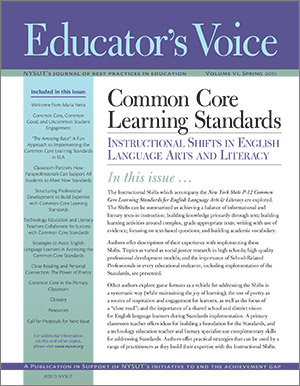Tapping into the skills and talents of classroom School-Related Professionals will help educators support students as they work to meet the new Common Core Learning Standards.
"If you have an SRP classroom partner, you have a wonderful resource to help your students succeed," said NYSUT Vice President Kathleen Donahue who oversees SRP services for the union. "SRPs can support student success in a variety of ways, such as facilitating critical thinking."
Writing in the most recent edition of Educator's Voice, NYSUT's journal of best practices in education, Barbara Ellis, a retired educator who teaches classes for SRPs at Empire State College in New York City, outlined six ways to build successful classroom partnerships:
1. Get to know your SRP.
Some SRPs speak multiple languages, for example, or have artistic talents.
"Include your paraprofessionals in whatever you are doing. You may find a wealth of untapped talent," Ellis said. "The benefits to your students are immense."
Schenectady Federation of Teachers member Katie Ferguson agrees. The 2012 New York State Teacher of the Year now has a special education paraprofessional and a special education teacher working in her second grade classroom for a portion of each day.
"It's a little like a marriage; you have to get used to each other," Ferguson said. Be specific about what you want, she advises, and take the time to learn about your paraprofessional's background and educational philosophy.
2. Advocate for SRPs to have equal access to professional development.
Ellis advises SRPs to seek professional development opportunities on their own. Professional development classes "bridge the classroom teacher and the para and the learning community," said Ellis. NYSUT's Education & Learning Trust courses and the SRP Leadership Conference are great resources for SRPs.
3. Explore Universal Design for Learning.
UDL gives students multiple ways to access and engage with content and express what they know. Ferguson appreciates the unique contribution her paras make in this learning process.
"Inevitably they get to work with students in a different setting than I do," she said, like while walking through the halls at lunchtime or recess. "Getting the paras' perspective on things they may know that I do not know is incredibly helpful."
4. Share students' IEP and/or 504 accommodations as well as annual goals.
An SRP, for example, who doesn't know "wears glasses" is part of a student's IEP won't know to ask the student "Where are your glasses?" or whether the student is seeing the board clearly, Ellis points out. She writes that it's important for SRPs to know the goals, modifications and accommodations for students with disabilities and clearly understand all confidentiality requirements regarding a student's information.
5 Develop tools to use together.
Ellis suggests using tools such as academic vocabulary, text-dependent questions and graphic organizers.
Ferguson says her paraprofessionals lead small groups to review skills. The format can vary according to the subject matter and may include repeating or rephrasing, monitoring, simplifying or modifying an assignment.
Annie McClintock, a high school teaching assistant, provides student support in multiple content areas.
"I am so very lucky to work with some really great and innovating teachers who provide me with their lesson plans, handouts, homework assignments, quizzes, tests and answer keys in advance," said McClintock, president of the United Teaching Assistants of Harborfields and member of NYSUT's SRP Advisory Committee. "These teachers get it! The better informed I am, the better able I am to provide support."
6. Acknowledge the contributions of all team members.
"I have an amazing team," Ferguson said, and points to specific strengths of the various professionals in her classroom. Ferguson said she always provides feedback to her team and includes them whenever possible in planning discussions.
Classroom teachers always use a variety of methods to help students master skills and concepts. For educators who have SRPs as classroom partners, taking time to strategize how his or her skills and talents can benefit students can pay dividends in providing students multiple opportunities to process information and meet the standards.
Be upfront with what you want and listen to your SRP, Ferguson said. "Also, sometimes you just have to compromise," she said. "It may not be your way all the time. And that's OK."
Get your copy

The current edition of Educator’s Voice, NYSUT's journal of best practices in education, features eight articles and related sources on instructional shifts that accompany Common Core Learning Standards, including "Classroom partners: How paraprofessionals can support all students to meet new standards."
"We are proud to provide a forum for educators to share their expertise," said NYSUT Vice President Maria Neira, who oversees education policy for the union and heads the editorial board of Educator’s Voice. It is available for download online at www.nysut.org/educatorsvoice.